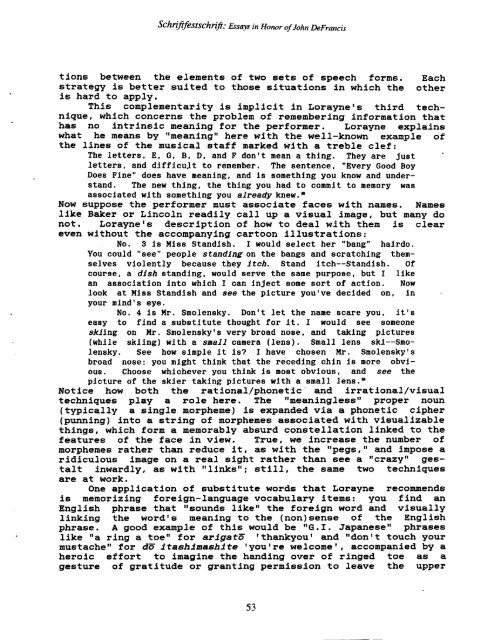Essays on Writing and Language in Honor - Sino-Platonic Papers
Essays on Writing and Language in Honor - Sino-Platonic Papers
Essays on Writing and Language in Honor - Sino-Platonic Papers
You also want an ePaper? Increase the reach of your titles
YUMPU automatically turns print PDFs into web optimized ePapers that Google loves.
Schn$$estschn!jf: &sap <strong>in</strong> H<strong>on</strong>or of John &Francis<br />
ti<strong>on</strong>s between the elements of two sets of speech forms. Each<br />
strategy is better suited to those situati<strong>on</strong>s <strong>in</strong> which the other<br />
is hard to apply.<br />
This complementarity Is Implicit <strong>in</strong> Loraynets third tech-<br />
nique, which c<strong>on</strong>cerns the problem of remember<strong>in</strong>g <strong>in</strong>formati<strong>on</strong> that<br />
has no <strong>in</strong>tr<strong>in</strong>sic mean<strong>in</strong>g for the performer. Lorayne expla<strong>in</strong>s<br />
what he means by "mean<strong>in</strong>g1' here with the well-known example of<br />
the l<strong>in</strong>es of the musical staff marked with a treble clef:<br />
The letters, E, G, B, D, <strong>and</strong> F d<strong>on</strong>'t mean a th<strong>in</strong>g. They are just<br />
letters, <strong>and</strong> difficuJt to remember. The sentence. "Every Good Boy<br />
Does F<strong>in</strong>e" does have mean<strong>in</strong>g, <strong>and</strong> is someth<strong>in</strong>g you know <strong>and</strong> under-<br />
st<strong>and</strong>. The new th<strong>in</strong>g, the th<strong>in</strong>g you had to commit to memory was<br />
associated with someth<strong>in</strong>g you already knew."<br />
Now suppose the performer must associate faces with names. Names<br />
like Baker or L<strong>in</strong>coln readily call up a visual image, but many do<br />
not. Loraynets descripti<strong>on</strong> of how to deal with them is clear<br />
even without the accompany<strong>in</strong>g carto<strong>on</strong> illustrati<strong>on</strong>s:<br />
No. 3 is Miss St<strong>and</strong>ish. I would select her "bang" hairdo.<br />
You could "see" people st<strong>and</strong><strong>in</strong>g <strong>on</strong> the bangs <strong>and</strong> scratch<strong>in</strong>g them-<br />
selves violently because they Itch. St<strong>and</strong> itch--St<strong>and</strong>ish. Of<br />
course, a ddsh st<strong>and</strong><strong>in</strong>g, would serve the same purpose, but I like<br />
an associati<strong>on</strong> <strong>in</strong>to which I can <strong>in</strong>ject some sort of acti<strong>on</strong>. Now<br />
look at Miss St<strong>and</strong>ish <strong>and</strong> see the picture you've decided <strong>on</strong>, <strong>in</strong><br />
your m<strong>in</strong>d's eye.<br />
No. 4 is Mr. Smolensky. D<strong>on</strong>'t let the name acare you, it's<br />
easy to f<strong>in</strong>d a substitute thought for it. I would see some<strong>on</strong>e<br />
ski<strong>in</strong>g <strong>on</strong> Mr. Smolensky's very broad nose, <strong>and</strong> tak<strong>in</strong>g pictures<br />
(while ski<strong>in</strong>g) with a small camera (lens). Small lens ski--Smo-<br />
lensky. See how simple it is? I have chosen Mr. Smolensky's<br />
broad nose; you might th<strong>in</strong>k that the reced<strong>in</strong>g ch<strong>in</strong> is more obvi-<br />
ous. Choose whichever you th<strong>in</strong>k is most obvious, <strong>and</strong> see the<br />
picture of the skier tak<strong>in</strong>g pictures with a small lens.=<br />
Notice how both the rati<strong>on</strong>al/ph<strong>on</strong>etic' <strong>and</strong> irrati<strong>on</strong>al/visual<br />
techniques play a role here. The "mean<strong>in</strong>gless" proper noun<br />
(typically a s<strong>in</strong>gle morpheme) is exp<strong>and</strong>ed via a ph<strong>on</strong>etic cipher<br />
(punn<strong>in</strong>g) <strong>in</strong>to a str<strong>in</strong>g of morphemes associated with visualizable<br />
th<strong>in</strong>gs, which form a memorably absurd c<strong>on</strong>stellati<strong>on</strong> l<strong>in</strong>ked to the<br />
features of the face <strong>in</strong> view. True, we <strong>in</strong>crease the number of<br />
morphemes rather than reduce it, as with the "pegs," <strong>and</strong> impose a<br />
ridiculous image <strong>on</strong> a real sight rather than see a "crazy" ges-<br />
talt <strong>in</strong>wardly, as with "l<strong>in</strong>ks"; still, the same two techniques<br />
are at work.<br />
One applicati<strong>on</strong> of substitute words that Lorayne recommends<br />
is memoriz<strong>in</strong>g foreign-language vocabulary items: you f<strong>in</strong>d an<br />
English phrase that "sounds like" the foreign word <strong>and</strong> visually<br />
l<strong>in</strong>k<strong>in</strong>g the word's mean<strong>in</strong>g to the (n<strong>on</strong>)sense of the English<br />
phrase. A good example of this would be "G.1. Japanese" phrases<br />
like "a r<strong>in</strong>g a toe" for ardgat8 'thankyou' <strong>and</strong> "d<strong>on</strong>'t touch your<br />
mustachen for d5 itashfmashite 'you're welcome', accompanied by a<br />
heroic effort to imag<strong>in</strong>e the h<strong>and</strong><strong>in</strong>g over of r<strong>in</strong>ged toe as a<br />
gesture of gratitude or grant<strong>in</strong>g permissi<strong>on</strong> to leave the upper

















